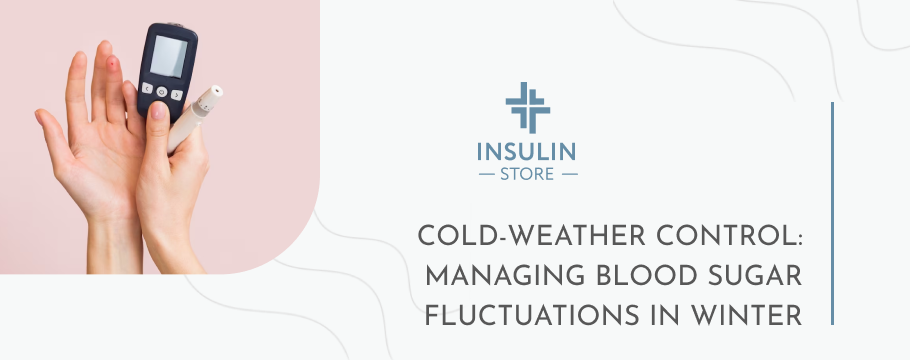
Cold-Weather Control: Managing Blood Sugar Fluctuations in Winter
Even though the winter season is exciting and many people look forward to it, this time can be challenging for individuals with diabetes because it involves rapid changes in their lifestyles, which can affect blood sugar levels significantly. Cold temperatures can interfere with one’s ability to manage diabetes, but it doesn’t mean you cannot enjoy this magical time and must move to warmer lands to survive winter. Here in this article, we will mention all the essentials about living with diabetes mellitus during winter; as a bonus, we’ll mention some helpful tips on diabetes management you may easily incorporate into your routine.
Please note that Insulin.Store is a Canadian insulin supplier ready to cooperate with diabetics from the USA and supply them with all needed medications at advantageous prices. Mind that any insulin belongs to the prescription medication class, meaning you can only order on this website if you have a valid prescription from your doctor. Contact our managers if you have any questions or need assistance.
Are Blood Sugar Control Problems During Winter Real?
A diabetes management plan is a crucial thing for any time of the year; whether it’s hot or cold outside, people must be careful to keep their blood glucose level within a normal range. However, some factors may affect one’s ability to manage diabetes during winter, especially regarding rapid changes in the temperature outside, vitamin deficiency, and other essentials. So, we would say that this statement is true: some people find it more challenging to manage blood sugar during the winter season. Still, the recommendations for this process are pretty similar to the regular ones, and we are going to discuss them in the following paragraphs, so continue reading to refresh your knowledge or learn new helpful information on how to accommodate to new weather conditions while keeping blood glucose within the average numbers.
Why Do I Experience High Blood Sugar Levels in Winter?
The truth about managing diabetes mellitus during winter is that even if you take your diabetes medicines as prescribed and don’t skip the infusions, extreme cold can sometimes affect your blood sugar levels. Numerous reasons can cause this problem, and we’ll list them below so you can remember them and consider if any unfortunate accidents happen with your diabetes control during the winter season:
- Vitamin D deficiency. According to studies, vitamin D is crucial for decent insulin sensitivity, so its efficiency may affect one’s blood sugar levels. During winter, we go out rarely, so vitamin D deficiency is only natural, even if you add supplements to your diet;
- Poor eating habits. Winter is full of festivities and holidays, meaning there is plenty of food and drinks to consume to celebrate life. In addition, most of those foods are sugary and don’t go well with a well-planned diabetes diet;
- Reduced physical activities. Who likes going out when it’s freezing cold outside? Winter minimizes the variety of physical activities significantly, and the lack of movement can cause insulin resistance and raise blood glucose levels;
- Higher risk of catching a cold. Statistically, people get sick more often during winter, mainly with regular colds and flu. And surely we stress out about this, so the level of cortisol in the body rises, impacting insulin release;
- Weight changes. People tend to gain weight during winter, as the body requires more fat to stay warm. Plus, we tend to gain weight faster due to a sedentary lifestyle. Sudden weight changes may affect one’s blood sugar control abilities significantly;
- Dehydration. When it’s cold, we feel less thirsty, meaning daily water intake is reduced significantly, as we simply forget about it. As a result, it leads to dehydration, which impacts blood glucose.
To reduce the risks, it’s important to maintain a healthy diet and plan your routine in a way appropriate for your needs and lifestyle. If you have problems doing it on your own, we highly recommend talking to a medical professional so they can give you pieces of advice according to your unique conditions.
Signs of High Blood Glucose Levels
Knowing the main symptoms of those is essential to detect high or low blood sugar levels on time. Surely, you are probably aware of all the nuances if you have managed diabetes for many years; still, we believe it’s still worth reminding you of the main signs of increased blood sugar to keep you safe and help you notice the problem on time:
- Shivering, cold sweats;
- Slower wounds healing;
- Frequent urination;
- Increased feeling of hunger;
- Sudden weight changes;
- Weakness, fatigue;
- Blurred vision;
- Increased heart rate.
If you notice any of these, it’s better to check blood sugar levels by using a blood glucose meter (also known as a glucometer) or a continuous glucose monitor (CGM). You may also consider a fasting blood sugar test in the hospital.
Tips for Blood Sugar Level Management
As for the blood sugar management recommendations for the winter season, we have a few tips and tricks you may find helpful. These are universal so that most patients can use them safely for a pleasant time during cold months.
#1. Check Your Skin and Feet Carefully
During winter, skin tends to dry more, so little cracks on the body surface are more common, especially in the feet area. That’s why proper moisturizing is vital; in addition, we recommend getting good footwear that can protect sensitive skin on your feet from sores, cuts, and wounds. If you notice any type of skin damage on your feet, please contact a specialist immediately to receive all the instructions on how to take care of this condition and avoid unfortunate complications.
#2. Don’t Skip Exercises
We understand that it may be challenging to stay active when all you want to do is wrap up in a warm blanket and stay cozy in your bed. However, staying active helps the body work with insulin better, thus regulating blood sugar levels more effectively. Plus, workouts give a prominent boost to one’s mood, which is always beneficial for people’s general well-being.
#3. Keep Your Supplies Out of the Cold
Just like the situation with extreme heat, extreme cold can be damaging for various medications, including insulin. It doesn’t matter whether you use insulin pumps, vials, or pens, – temperature control is essential to preserve the drug’s quality. Plus, low temperatures may affect the glucometer’s work, so we don’t recommend leaving your supplies in the car or on a cold windowsill.
#4. Reconsider Your Diet
Hearty meals can be comforting, but you may crave sweets and fatty foods. However, you must always count the carbs of what you eat to prevent overeating, count your insulin doses according to what you eat, and try to come up with safe, comforting meals. For example, warm soups with chicken broth and delicious vegetables can be an excellent option to warm up during cold winter.
#5. Always Stay Hydrated
High temperatures always help us stay hydrated, as we feel thirsty more often, and thus the water intake grows. However, during winter, people tend to forget about drinking water, so it’s important to set yourself a reminder and control your water intake.
To Sum Up: Managing Diabetes During Winter
To enjoy a magical wintertime, it’s vital to take good care of your health and ensure your blood sugar levels are maintained within a safe range to avoid diabetes complications. Just remember the simple recommendations we’ve mentioned above: stay warm, always check out the condition of your skin (especially in the feet area), keep up with a healthy diet, and keep your insulin supplies warm. In case you need some tips related to particularly your case, it’s better to talk to your doctor, as they are the only ones who know your unique case and can develop a strategy to stay safe and healthy during winter. Hopefully, you found some valuable pieces of advice in this article. We hope you’ll stay strong and healthy in 2024!
